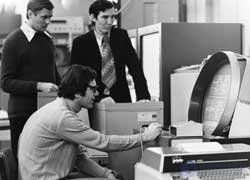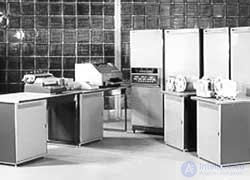Lecture
Integrated circuits have become the element base of computers of the third generation. An integrated circuit is a circuit made on a semiconductor chip and placed in a case. Sometimes an integrated circuit is called a microcircuit or a chip. Chip in English - sliver. This name he received because of its tiny size. The first chips appeared in 1958. Two engineers almost simultaneously invented them without knowing about each other. This is Jack Kilby and Robert Noyce. The first Soviet IS was created three years late. But the widespread use of integrated circuits began only in the early 70s. These chips forever changed the image of computers. In third-generation computers, one integrated circuit could replace up to a thousand transistors and other basic elements. And each such element could replace up to several tens of electron tubes. This gave a huge miniaturization and reduction in the cost of production of computers.
All elements of the previous generation are produced on the same substrate and in the same IC package. Using the same manufacturing operations. The working area of the chip is the surface between the crystal and the metal , which is applied by spraying technology. This happens in a vacuum when the atoms of one material bombard the atoms of another.
For the mass production of such microchips began to create separate production lines. The quality of the final product was not achieved immediately. With the accumulation of experience, we have established a complete technological process. The chip size can be several millimeters. And the sizes of elements are measured in microns.
Such an achievement in the field of miniaturization made it possible to create computers, the size of which was like a desk. Separate rooms and whole halls were not needed. The entire computing center could fit in one room. And to provide power for such computers, two or four kilowatts is enough. And most importantly, the reliability of third-generation computers is not much inferior to today's technology.
Third-generation computers could be found on board an aircraft, a ship, a submarine, a satellite. Tangible fruits microminiaturization. These machines were called Mini-Computers. And despite the fact that the alphanumeric displays appeared in the second generation of machines. On the third, they finally entrenched themselves. And they have become an integral part of the computer.
Many machine operations began to be performed immediately with a group of bits. Which they considered as one. The size of this group on many computers was eight bits. Which kept. Processed and transmitted simultaneously. In the information world is fixed the word byte . One byte is eight bits. Using a byte is quite convenient. And greatly simplifies working with data on the machine. One byte means one character. One byte is a coded decimal number from 0 to 255. Then a set of 2 or 4 bytes is called as a machine word. Third-generation computers began to have special teams consisting of such pairs of bytes. But logically denoting a single operation.
The memory of computers of this generation has increased significantly. Magnetic disks began to be used as external memory. The magnetic disk drive represented several disks rotating on one spindle. The disks were located at a short distance from each other. Between them was a block heads. Which were positioned simultaneously. What made it possible to read-write simultaneously on several disks simultaneously. The capacity of such drives was measured in millions of bytes. This was a significant step compared to punch cards and magnetic tapes. The reliability of such drives is not inferior to external memory on magnetic drums. Now, third-generation computers are produced only in series. There are no single copies, as was the case with the first generation, and sometimes with the second one. Now it is only mass production.
One of the most important distinguishing features of the second and third generation is the emergence of an open computer architecture. A vivid example of a computer System / 360 production IBM. The open architecture makes it easy to repair parts replacement. And most importantly, some components can be suitable for different models of computers and even to different manufacturers of computers. The production of this series of cars began in 1964 and was the greatest success of IBM. It has become the standard of computers all over the world.
In Soviet Russia, after eight years, the imitation of System / 360 appeared. It was an EC computer (Single Series). Computer EC-1010, EU-1020, EU-1030, EU-1040, EU-1060. In the development of this series are participating Bulgaria, Hungary, Czech Republic. The production of Soviet computers begins: Mir-31, Mir-32, ASVT M-6000, ASMT M-7000. To produce more compact computers: Electronics-79, Electronics-100, Electronics-125, Electronics-200.
Computer EC-1010. It has a speed of 10 thousand operations per second. EU-1020 speed of 20 thousand operations per second, 64 KB of RAM, external memory on magnetic tapes and disks.


Computer software is becoming more powerful. The first text editors appear. But they are not widely distributed. It is too expensive to use a Minicomputer instead of a typewriter. Database management systems appear. They are beginning to be used everywhere by commercial organizations. Some acquire computers only for the sake of creating and managing their databases. Third-generation computers are no longer a luxury for businesses.
The first and second generation machines used only the military, government departments and institutions. Now they are available even for small companies. The average price of a third generation car is 20-30 thousand dollars. Which is quite possible for many organizations. Appear automated design systems.
There is a huge need for application software. As a result, each company employs its own staff of programmers who perform current tasks. The software market itself is not yet available. Therefore, it is impossible to buy the necessary program or library. Many third-generation computers, like previous generations, are not compatible with each other in hardware and software. IBM, with its System / 360 machine, is just starting to correct this error.
Comments
To leave a comment
History of computer technology and IT technology
Terms: History of computer technology and IT technology